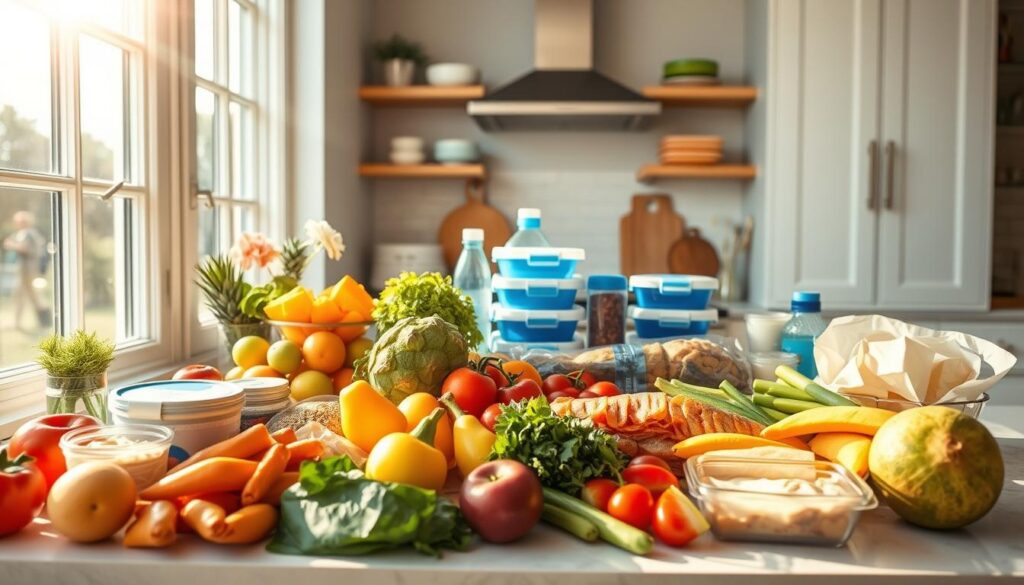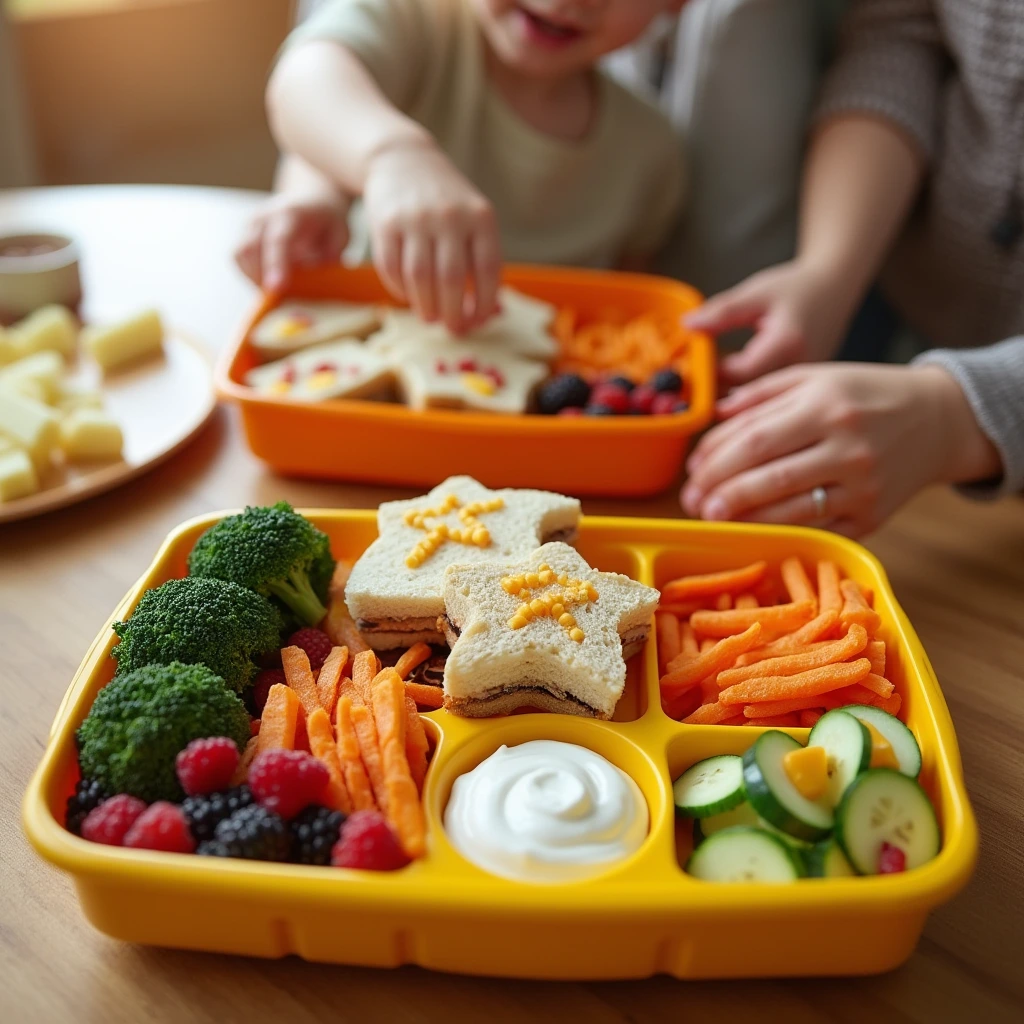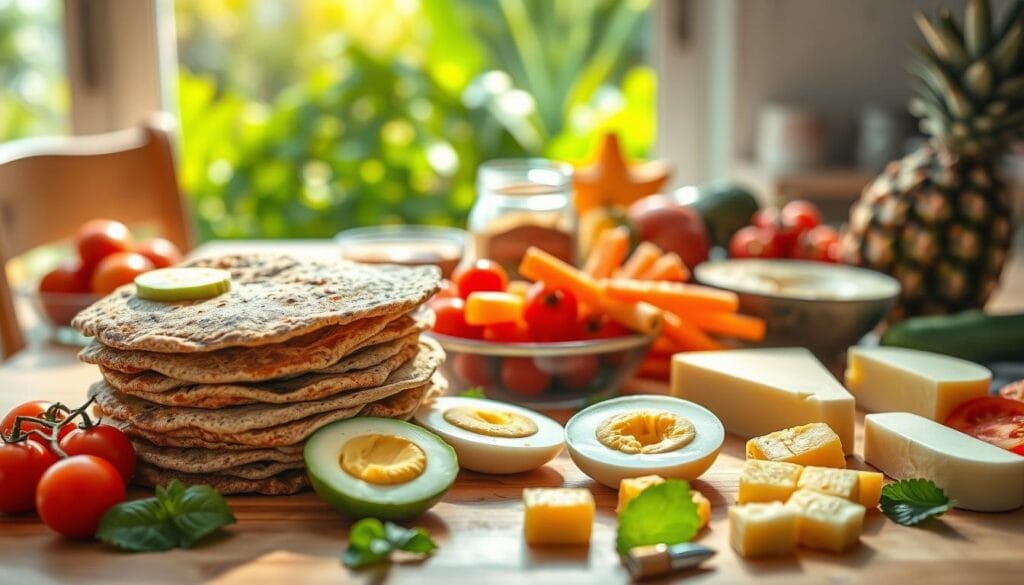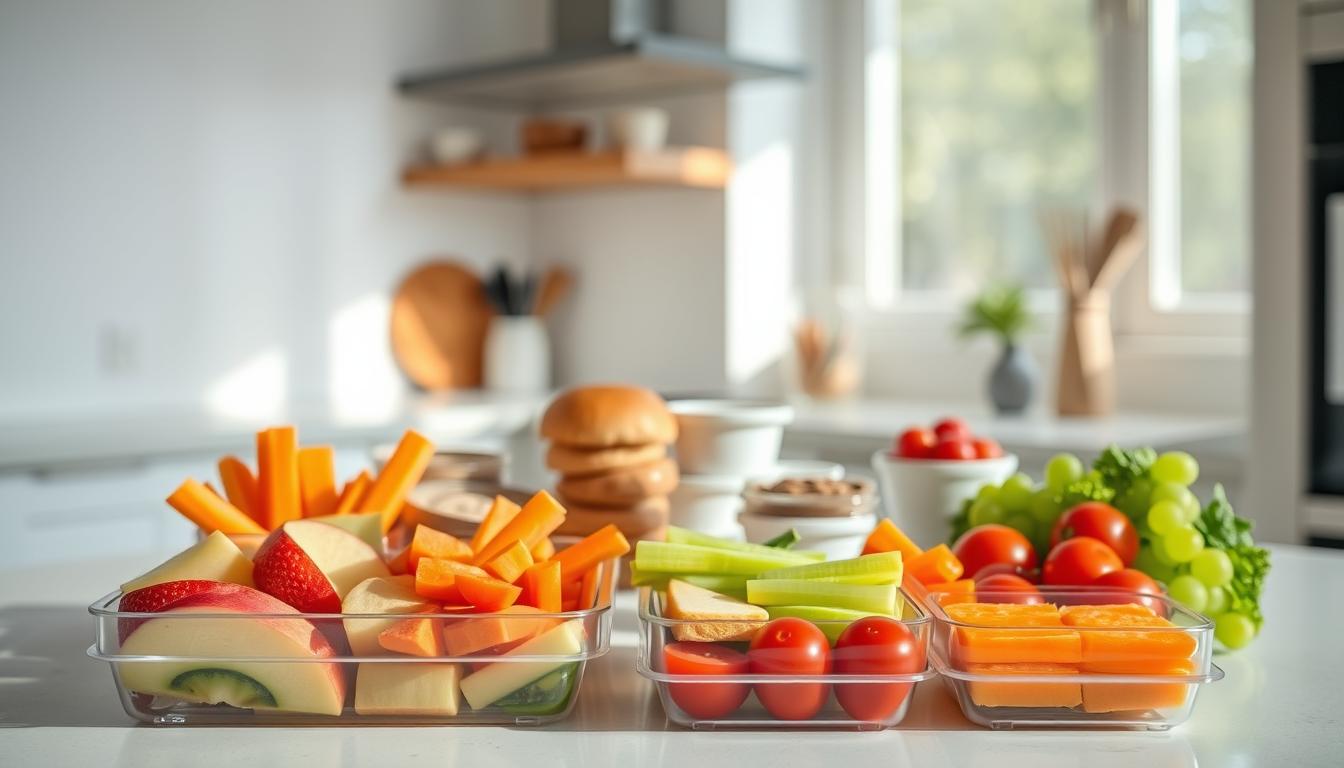Table of Contents
Imagine the morning rush, trying to pack lunches that your child will like. You need meals that give them energy for school and fit your busy life. It’s a challenge to find healthy childrens lunch ideas that are quick and appealing.
These kid-friendly meals do more than just meet requirements. They help your child stay focused, have fun, and develop good eating habits. This guide makes it easier to find meals that work for you and your kids.
Key Takeaways
- Quick and nutritious lunches that save time without sacrificing taste
- Practical strategies for budget-friendly healthy childrens lunch ideas
- Recipes adaptable to allergies, preferences, and dietary needs
- Proven methods to turn picky eaters into willing participants
- Expert-backed tips to keep meals fresh and appealing all week
Why Nutritious Lunches Matter for Your Child’s Development
Nutritious school lunches are more than just a break. They are key to your child’s daily health. The right balanced meals for children fuel their brains and bodies. This sets the stage for long-term health.
Research shows that what kids eat impacts their learning, growth, and well-being.
The Link Between Nutrition and Academic Performance
Studies show that kids who eat nutritious school lunches stay focused longer. A 2023 USDA report found kids who eat balanced meals score 15% higher on tests. Foods like turkey wraps or yogurt parfaits boost memory and concentration.
How Healthy Lunches Support Physical Growth
Physical growth needs consistent nutrients. A balanced lunch provides essential nutrients:
| Nutrient | Food Sources | Benefits |
|---|---|---|
| Calcium | Milk, cheese, leafy greens | Strengthens bones and teeth |
| Iron | Lean beef, lentils, fortified cereals | Supports energy levels and brain function |
| Vitamin D | Eggs, fortified milk, sunlight | Aids calcium absorption and immunity |
Building Lifelong Healthy Eating Habits
Children learn from what they see. Serving nutrient-rich lunches teaches them to value healthy foods. Early introduction to variety, like mixing veggies into pasta, helps avoid picky eating.
These habits reduce chronic disease risks and promote self-care in adulthood.
Essential Nutrients Every Child’s Lunch Should Include
Creating balanced meals for children starts with knowing the key nutrients. Nutritious school lunches need proteins, carbs, healthy fats, and vitamins to help kids grow and stay focused. Here’s how to include each:
- Protein: Chicken, tofu, or Greek yogurt to support muscle growth and brain function.
- Complex Carbohydrates: Whole grain pasta, brown rice, or whole wheat tortillas for steady energy.
- Healthy Fats: Almonds, chia seeds, or olive oil to aid vitamin absorption and satiety.
Micronutrients matter too. Add:
- Calcium (milk, cheese) for strong bones.
- Iron (lentils, spinach) to prevent fatigue.
- Vitamin C (oranges) to boost immunity and iron absorption.
A simple formula works: protein + whole grain + veggie/fruit + healthy fat. For example, grilled chicken strips with quinoa salad, carrot sticks, and sunflower seeds.
Watch for common gaps like low fiber or omega-3s. Swap sugary snacks for edamame or berries. Even small portions of these foods add up to a well-rounded meal. Keep lunches interesting and nourishing by trying different foods.
Quick and Easy Healthy Children’s Lunch Ideas for Busy Mornings
Mornings can be hectic, but making a healthy lunch doesn’t have to be. These easy lunch recipes for kids and lunchbox ideas are quick and nutritious. Start your day without stress with these time-saving tips that keep your meals healthy.
No-Cook Lunch Options
- Make lunchbox ideas like whole-grain wraps with hummus, cucumber, and turkey. Add apple slices with almond butter.
- Build yogurt parfaits with Chobani Greek yogurt, fresh berries, and Nature’s Path granola.
- Offer cheese cubes, whole-grain crackers, and cherry tomatoes in a fun arrangement.
5-Minute Prep Recipes
- Quickly make quesadillas with black beans, lettuce, and cheese. Cut into wedges for fun.
- Prepare pasta salad with Annie’s Organic Bunnies pasta, cherry tomatoes, and a light vinaigrette. Make it in bulk on Sundays.
- Layer tuna salad in a whole-wheat pita with pickles and carrot sticks.
Make-Ahead Lunch Solutions
- Batch-cook grains like quinoa or couscous on weekends. Store in airtight containers for quick bowls with veggies.
- Freeze pre-cut fruits like pineapple or mango for easy grab-and-go options.
- Prep proteins ahead: grill chicken strips or hard-boil eggs for a quick addition to any lunchbox.
Budget-Friendly Lunch Options That Don’t Sacrifice Nutrition
Nutritious school lunches don’t have to break the bank. Many think healthy meals are expensive, but smart planning can save money. Start by buying seasonal fruits and veggies at local farmers’ markets or bulk bins at stores like Costco or Walmart. Canned beans, eggs, and whole grains like oatmeal or quinoa are affordable and rich in protein and fiber.

- Use frozen vegetables—like peas or mixed veggies from brands like Birds Eye—for quick, budget-friendly additions.
- Repurpose last night’s dinner into healthy childrens lunch ideas. Leftover chicken stir-fry becomes tomorrow’s pita pockets.
- Buy store-brand whole-grain bread and wraps to cut costs without sacrificing fiber.
Try these cost-effective combos: Hard-boiled eggs (99¢ each) paired with whole-grain crackers and a banana cost under $2. Canned tuna (from brands like Wild Planet) mixed with plain Greek yogurt and veggies makes a protein-packed salad for under $3. Even small changes add up—prepackaged snacks often cost twice as much as homemade versions. Planning meals weekly helps reduce waste and keeps your budget on track. With these strategies, you can pack nutritious school lunches that keep your child fueled and your wallet happy.
Navigating Food Allergies and Dietary Restrictions
It’s easy to make sure your child’s lunches are safe and tasty. These kid-friendly meals and lunchbox ideas fit dietary needs without losing flavor. First, check food labels for warnings about cross-contamination. Also, make sure to follow your school’s rules on what foods are off-limits.
Gluten-Free Lunch Ideas
- Use Canyon Bakehouse gluten-free wraps or rice cakes instead of regular bread.
- Try quinoa salads with veggies or Bob’s Red Mill pasta for a carb boost.
- Pair with dips like hummus or guacamole for hands-on eating.
Dairy-Free Alternatives
Replace milk with almond or oat milk (choose unsweetened options like Silk). For calcium, add leafy greens or Follow Your Heart vegan cheese. For mac-and-cheese, try Beyond Famous Foods plant-based versions.
Nut-Free School-Safe Options
- Swap peanut butter for SunButter sunflower seed spread on rice crackers.
- Include protein-rich options like turkey rolls or hard-boiled eggs (if allowed).
- Add dried fruit or roasted chickpeas for crunch without allergens.
Always pack items in clear containers so teachers can spot-check for safety. Small tweaks turn restrictions into creative opportunities—your child’s lunch can stay both safe and satisfying.
Creative Lunchbox Strategies for Picky Eaters
Make lunchtime exciting by mixing creativity with healthy food. Even the pickiest eaters can start to enjoy meals. This happens when they’re presented in fun and engaging ways.
Making Vegetables Appealing
Make veggies fun to discover. Roast carrots until they’re sweet or slice zucchini into strips for creative lunch ideas. Mix spinach into pasta sauces or blend beets for colorful dips.
Pair raw veggies with yogurt or nut-free spreads. This makes them fun to try without feeling forced.

Fun Presentation Techniques
- Use cookie cutters to shape sandwiches into stars or animals.
- Arrange snacks in bento boxes with compartments for healthy snacks for kids like berries, cheese cubes, and apple slices.
- Build “dinosaur forests” with broccoli trees and cucumber rivers.
Involving Your Child in Lunch Planning
Let kids pick one ingredient or make their own mini meals. Let them choose a veggie or add toppings to proteins. Giving them choices makes them feel more involved.
Try a “snack bar” where they can make their own yogurt or veggie wraps. Small changes can make a big difference. Focus on fun, familiarity, and teamwork to help them make healthy choices.
Seasonal Lunch Inspiration: From Summer to Winter
Seasonal ingredients make school lunch inspiration easy. Fresh, in-season foods are full of flavor and nutrients. Teach your kids about nature’s cycles while creating colorful lunchbox ideas that match the weather.
| Season | Key Ingredients | Lunchbox Ideas |
|---|---|---|
| Summer | Strawberries, corn, watermelon | Cold veggie noodles with dip, frozen fruit popsicles |
| Fall | Apples, pumpkin, carrots | Microwaveable soups, roasted veggie wraps |
| Winter | Oranges, sweet potatoes, pears | Whole-grain sandwiches with avocado, steamed veggie packs |
| Spring | Asparagus, peas, radishes | Mini frittatas, raw veggie platters with dips |
Stock up on seasonal produce when it’s cheapest and freshest. Freeze berries in summer for winter smoothies. Let kids pick new veggies at the grocery store to try in their lunches. Seasonal eating saves money and reduces food waste—buying what’s in season cuts costs by up to 30%.
Pair seasonal meals with learning: explain where foods grow and how they’re harvested. This turns lunch prep into a fun science lesson. Adjust portions for weather—lighter meals in summer, hearty soups in winter.
Protein-Packed Lunch Ideas to Keep Kids Energized All Day

Protein is key for kids to stay sharp and active. It’s important for growth and energy, no matter if they love sports or reading. Here’s how to add protein to their meals without losing flavor or wasting time.
Plant-Based Protein Options
- Try chickpea wraps with hummus, spinach, and veggies.
- Add roasted edamame as a crunchy side dish.
- Use quinoa salads mixed with diced apples and walnuts.
Lean Meat Alternatives
Choose from:
- grilled chicken skewers with tzatziki dip.
- turkey lettuce wraps stuffed with avocado.
- salmon burgers baked with whole-grain buns.
Protein-Rich Snack Additions
Enhance meals with:
- Single-serve Greek yogurt cups (6g protein per oz).
- Cheese cubes or string cheese from brands like President.
- Trail mix with nuts/seeds (if allowed) and dried fruit.
| Food | Protein (per serving) | Quick Prep Idea |
|---|---|---|
| Edamame | 11g | Season with garlic powder before microwaving |
| Hard-boiled eggs | 6g | Peel and portion into a reusable container |
| Black bean tacos | 7g | Layer in mini corn tortillas with salsa |
| Turkey roll-ups | 14g | Wrap turkey, cheese, and cucumber slices |
Mix proteins with whole grains and veggies for balanced meals for children. Adjust portions: 10-15g protein per meal for younger kids, up to 25g for teens. Pair with colorful veggie sticks or fruit for complete nutrition.
Smart Lunchbox Packing Tips to Maintain Freshness and Temperature
Keeping food fresh and safe is key to successful lunchbox ideas. Start by using insulated containers to protect perishables like yogurt or salads. Pair with freezer packs to keep items cold, and avoid leaving packed meals at room temperature for over two hours. For hot foods, use thermoses filled with broth-based soups or chili to stay warm.
Organize contents to prevent sogginess. Wrap lettuce in parchment paper before adding to sandwiches. Use small containers for dips or sauces so kids can portion them at lunchtime. Here’s how to maximize freshness:
- Layer crisp veggies like carrots or cucumber slices at the bottom of containers
- Freeze water bottles overnight— they’ll thaw by lunch and double as an ice pack
- Opt for whole fruits (apples, grapes) that stay fresh longer than cut produce
For school lunch inspiration, consider bento-style packing. Use divided containers to present colorful foods in bite-sized portions. Try:
| Container Type | Best Uses |
|---|---|
| Insulated bags | Cheese sticks, hard-boiled eggs |
| Silicone pouches | Homemade energy bites or dried fruit |
| Stainless steel containers | Hot meals like oatmeal or pasta salads |
Switch to reusable wraps like Bee’s Wrap or Stasher bags to cut waste. Pack utensils and napkins separately so kids can easily access everything. These simple strategies ensure lunches stay appealing and safe until lunchtime.
Balancing Treats and Nutrition: The 80/20 Approach
Healthy eating isn’t about being perfect—it’s about finding a balance. Eat nutrient-rich kid-friendly meals 80% of the time. Save 20% for treats now and then. This way, lunches stay fun without going too far.
Healthier Versions of Kid Favorites
Try making healthier versions of favorite foods:
- Whole-grain pizza pockets filled with spinach and turkey
- Mac and cheese with a cauliflower mash twist
- Whole-wheat chicken nuggets baked, not fried
Smart Sweet Treats That Won’t Cause Sugar Crashes
Choose healthy snacks for kids that are sweet but won’t crash their energy:
- Frozen yogurt bites with berries
- Dark chocolate squares (70%+ cocoa) with almonds
- Oatmeal cookies made with applesauce instead of oil
Teaching Moderation Without Restriction
Teach kids to make smart choices:
- Offer treats as part of lunch 1-2 times a week
- Let kids pick one “fun food” weekly to build autonomy
- Pair treats with veggies or protein to slow sugar absorption
Small treats in the right context help kids enjoy all foods without guilt. The aim is to build a lifelong habit of mindful, joyful eating.
Time-Saving Weekend Prep Methods for Week-Long Lunch Success
Weekends are great for meal prep to ease weekday stress. Plan a 5-day menu with easy lunch recipes for kids that they’ll love. Cook proteins like grilled chicken or roasted veggies on Sunday for quick lunches all week.
Make a shopping list by store section to save time at the grocery store. Chop veggies, cook grains, and portion proteins ahead of time. Keep them in airtight containers in the fridge or freezer. A special spot in your pantry for prepped items keeps things organized.
Here are some tips:
- Cook a big batch of whole-grain pasta or quinoa
- Roast chicken breasts or chickpeas for protein
- Prep fruit salads in individual portions
Use prepped items to make different lunches. For example, Tuesday’s chicken wrap can turn into Thursday’s rice bowl with veggies. This way, you get school lunch inspiration without cooking every day. Freeze leftovers like baked goods or cooked grains for later.
Get stackable containers and reusable bags to keep meals fresh. Label containers with what’s inside and the date. Spend 90 minutes on Sunday, and you’ll have healthy, varied lunches all week.
Conclusion: Transforming Lunch Routines Into Healthy Habits Your Kids Will Love
Healthy lunches for kids don’t have to be hard or costly. Focus on protein, whole grains, and fresh veggies for better focus and energy. The ideas shared, from veggie snacks to fun ways to serve, show how to make meals fun and healthy.
Being consistent is key. Simple steps like prepping on weekends or letting kids pick ingredients help. Avoiding too many rules keeps meals balanced. This way, treats are okay sometimes. Brands like Annie’s Homegrown offer healthy options for kids, making it easier to meet dietary needs.
These habits shape your child’s view of food for years. Begin with a protein-rich snack or a no-cook recipe. Over time, these choices become natural, creating a positive relationship with food. Every lunch is a chance to support their health and happiness.
FAQ
What are some healthy children’s lunch ideas that my kids will actually eat?
Try quinoa salad with veggies, turkey pinwheels in whole-grain tortillas, or mini pizzas on whole-grain English muffins. These options are tasty and good for them!
How can I make lunchbox meals more interesting for picky eaters?
Use fun ways like bento boxes or cookie cutters for shapes. Let your kids help pick what’s for lunch. This makes them more excited to try new foods.
Are there any quick and easy lunch recipes for kids that can be prepared in advance?
Yes! Make overnight oats, wraps, or pasta salads with veggies and protein. Keep them in the fridge for quick lunches.
What nutritious snacks should I include in my child’s lunchbox?
Include fruits, veggies, and proteins. Try apple slices with almond butter, yogurt with granola, or carrot sticks with hummus. These snacks keep your child full and focused.
How can I accommodate food allergies or dietary restrictions in my child’s lunches?
Choose ingredients without common allergens. Use rice wraps or quinoa for gluten-free options. For dairy-free, pick plant-based yogurt and cheese. Talk to your child’s school about their needs for a safe lunch spot.
Are there budget-friendly lunch options that are still nutritious?
Yes! Buy seasonal fruits and veggies, and cook with affordable ingredients like beans and lentils. Make big batches of chili or soup for several lunches.
What are some creative lunch ideas for summer camps?
For summer, try cold pasta salads, fruit skewers, or wraps. Use ice packs to keep things cool. Choose light, refreshing foods like cucumber sandwiches or chilled soup.
How can I teach my child moderation when it comes to treats in their lunch?
Use the 80/20 rule, focusing on healthy foods with occasional treats. Teach them to enjoy treats wisely. This helps them understand the value of balance.

